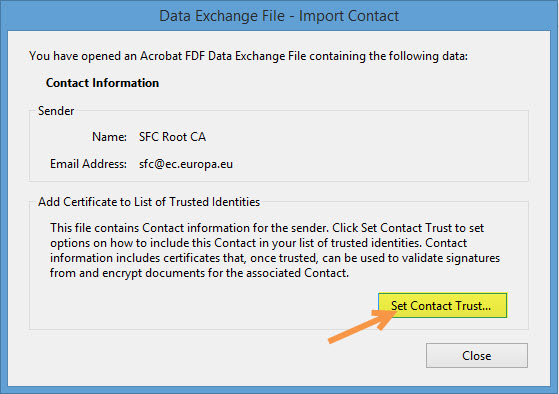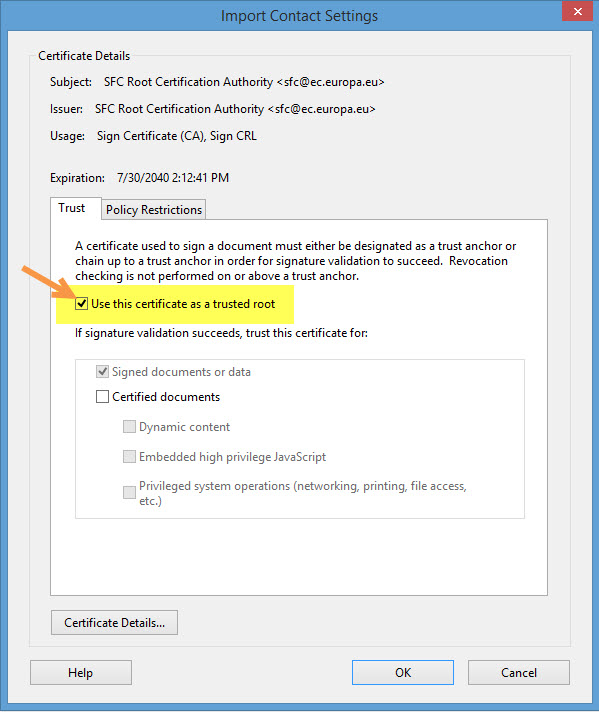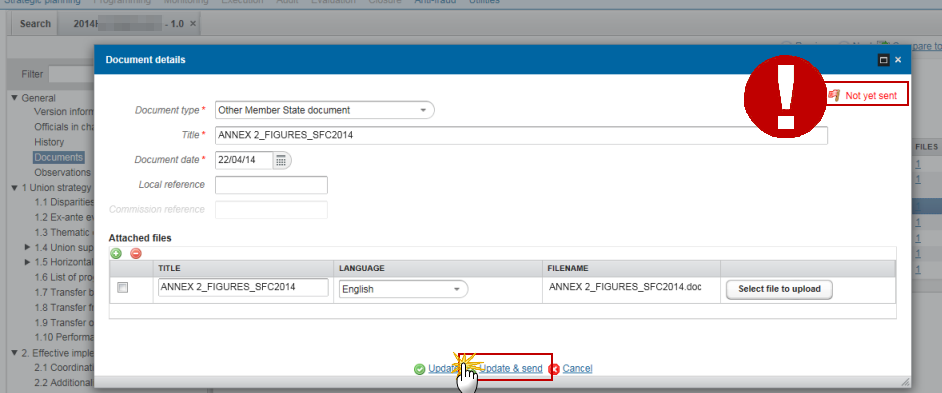
| Title | Description | Date |
|---|---|---|
|
|
07/03/2024
|
When an object is returned by the Commission in SFC2014 it will display as 'Current node' -> 'European Commission'. This is because the version that has been returned is no longer editable by the Member state and they must create a new version of the object in order to edit the information.
→ read more
SFC2014 enforces the "four-eyes" principle, which means that the user who last validated the Object cannot submit it. Two different users are required; one to validate and another to send.
According to Article 3(2) of Commission Implementing Regulation (EU) No 184/2014, “any transmission of information to the Commission shall be verified and submitted by a person other than the person who entered the data for that transmission. This separation of tasks shall be supported by SFC2014 or by Member State’s management and control information systems connected automatically with SFC2014.”
→ read more
The text boxes provided in SFC2014 follow the official templates. The limits are defined by the Commission implementing act and cannot be extended.
You can provide additional information in other documents which may help the Commission in its assessment of the programme by adding an 'Other Member State document' type in the document section. However, according to article 2(2) of Commission implementing regulation 184/2014 you cannot make references to this in the programme and the additional information will not form part of the programme covered by the Commission decision.
Article 2
Content of electronic data exchange system
1. The electronic data exchange system (hereinafter referred to as ‘SFC2014’) shall contain at least information specified in the models, formats and templates established in accordance with Regulation (EU) No 1303/2013, Regulation (EU) No 1299/2013, Regulation (EU) No 1305/2013 of the European Parliament and of the Council ( 3 ) and the future Union legal act establishing the conditions for the financial support for maritime and fisheries policy for the programming period 2014-2020 (the ‘EMFF Regulation’).
2. The information provided in the electronic forms embedded in SFC2014 (hereinafter referred to as ‘structured data’) may not be replaced by non-structured data, including the use of hyperlinks or other types of non-structured data such as attachment of documents or images. Where a Member State transmits the same information in the form of structured data and non-structured data, the structured data shall be used in case of inconsistencies.
→ read more
If you want to have a list like this in the free text editor:
1. aaaa
2. bbb
3. ccc
o ccc.111
o ccc.222
4. ddd
5. eee
6. fff
You have to follow these steps:
First start with the list without formatting:
aaaa
aaaa.1111
bbbb
Then you mark and number all of them (false) :
1. aaaa
2. aaaa.1111
3. bbbb
Then you indent the one(s) in the middle ( false) :
1. aaaa
1. aaaa.1111
2. bbbb
Then you change numbering to bullets (false) :
1. aaaa
o aaaa.1111
2. bbbb
The alternative is to edit first in a Word document and copy/paste from there.
→ read more
The size limit per file is 500MB.
There is no limit on the number of files or the total size of all files in an object.
The following file extensions are allowed:
“.7z”, “.bmp”, “.csv”, “.docx”, “.jpeg”, “.jpg”, “.msg”, “.ods”, “.odt”, “.odp”, “.odg”, “.odc”, “.odf”, “.odi”, “.odm”, “.ott”, “.ots”, “.otp”, “.otg”, “.pdf”, “.png”, “.pptx”, “.rar”, “.rtf”, “.tif”, “.tiff”, “.txt”, “.xlsb”, “.xlsx”, “.zip”, “.gif”, “.eml”
→ read more
The content of a programme can be seen by an EC user even before it is submitted to the Commission. This is to help the Member States during the amendments process.
Documents can only be consulted when they are sent. This is because documents do not have a full workflow as is the case for the structured data and their content is unknown and could contain sensible data which the Member State doesn't want the Commission to know before it is officially submitted.
Therefore, the "Other MS document" type and the "Informal Commission's Observations" document type were foreseen, so that the Member States could send whatever they want to send during the amendment process on an informal basis and the Commission could send them their observations already before the official submission.
→ read more
Unfortunately this is a problem in the Microsoft Edge browser, not in SFC2014.
The browser doesn't recognize it's a .pdf file. As a workaround you should save the file and give it the name and extension as indicated on the screen, then you will be able to open it in your downloads folder.
→ read more
The acknowledgement of receipt is signed with an electronic certificate guaranteeing the date and time of the signature as well as the integrity of this document. The certificate used to sign this document is held by the European Commission and can be verified by the corresponding public key.
The first step to validate the signature is to install the certificate in Acrobat.
(This step is only necessary once per machine)
- First download the SFC certificate file named CertExchangeSFCRootCA.FDF.
- Decompress the zip file and store the certificate on your computer.
- Open Acrobat.
- Go to File > Open and select the certificate from your computer.
- A pop up will be displayed. Click "Set Contact Trust…":
- On the next screen specify that this is a trusted root certificate by checking the option "Use this certificate as a trusted root" and click OK.
- A confirmation message will confirm the import. Click OK and close Acrobat.
→ read more
Once a document has been sent (there is a date visible in the 'sent date' column) it cannot be deleted.
However, if you are the sender of the document you may choose to 'hide' a sent document so that it is no longer visible within your programme by following the steps below:
1. In the Documents section of your OP (1) select the document from the list (2) and click the Edit button (3):
2. In the Document Details pop-up select the document you wish to hide (1)…
→ read more
If a Commission user cannot see the other documents you uploaded, this is because these are type 'Other Member State Document' and are sent independently (as you can see below there is no 'sent date') of the Object (PA, OP, RDP IR etc.).
The following steps should be taken for each document in order for them to be sent to the EC:
Select the document to be sent (1) and click on the edit button (2):
Click on the Update &Send link to send the document to the EC:
→ read more
PA - General
If your Member State is not eligible for CF you have to enter "0" amount for CF in the table of section 1.4.1 Union Support by Thematic Objective:
Validation rule 2.16 says:
validate against fixed Financial Allocations that the sum of the EU contributions per Member State and Fund in the Partnership Agreement (paragraph 1.4.1) are smaller or equal than the fixed Financial Allocations per Member State and Fund (error)
Total ERDF+ESF (1.4.1) <= Less developed + Transition + More developed + Outermost (Financial Allocations)
Total CF (1.4.1) <= Cohesion Fund (Financial Allocations)
Total EAFRD (1.4.1) <= EAFRD (Financial Allocations)
Total EMFF (1.4.1) <= EMFF (Financial Allocations)
Not all the Member States are eligible for CF!
To view the map with the countries eligible for CF please click here: http://ec.europa.eu/regional_policy/what/future/img/elig_1420_Mar12_CF_0810_A4P20_M.pdf
→ read more
The creation of a new version of the Partnership Agreement requires a user with Member State Authority (MSA) update access for all Funds concerned (EMFF, EAFRD, ERDF, CF, ESF, YEI) on the Top Level Member State node.
The validation and sending of the Partnership Agreement to the Commission requires two different users with Member State Authority (MSA) access - one user with update access and one with send access for all Funds concerned (EMFF, EAFRD, ERDF, CF, ESF, YEI) on the Top Level Member State node.
Every MS Liaison officer is authorised to grant MSA update and/or send access for any fund concerned.
→ read more
A Partnership Agreement (PA) submitted through SFC2014 will be considered as the official PA of the Member State.
Each Member State shall submit its PA to the Commission by 22 April 2014 (Article 14(4)). That means that the last day for submission is 21 April 2014.
After the submission, Commission has 3 months to provide observations (Article 16(1)), and 4 months to adopt a decision approving the PA (Article 16(2)).
Note that the time the Member State uses for providing replies to Commission observations does not count towards the 4 month deadline (Article 3).
For more information please refer to Regulation (EU) No 1303/2013 at http://eur-lex.europa.eu/LexUriServ/LexUriServ.do?uri=CELEX:32013R1303:EN:NOT
→ read more
Although the amounts in the PA may contain decimals, the values in the Annual Plan Table 17 should not have decimals. This is controlled by validation rule 2.61:
2.61 validate that in Table 17, the Main Allocation and the Performance Reserve amounts have no decimals (error) "The annual financing plan must be in euros, without decimals".
Following an internal discussion between the different DGs has been agreed that the programming and the commitments should be rounded to the euro as it has been done in the 2007-2013 period and not in cents. Total allocation in euro should also be respected.
This means that the performance reserve might not be exactly at 6% with this rounding to the euro. In that case the figures should be rounded to the closer euro or at least not to diverge by more than 99 cents from the 6%.
The main reason for being stricter with the OP is that the financial plan of the OP (namely Table 17) is the basis used for the commitments in the EU budget unlike figures in PAs. DG BUDG has reaffirmed this though line on OPs.
Only Table 17 must be rounded to the Euro. All other tables can have decimals, although their totals must be consistent between the different tables! So there's no problem in having decimals in Tables 18a, 18b and not in Table 17 as long as the total sum per Fund/Category of Region of Tables 18a and 18b has no decimals.
→ read more






